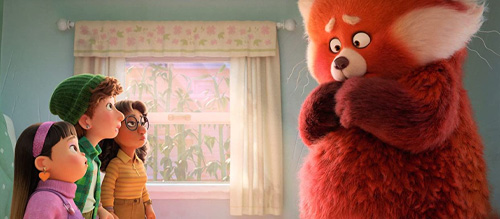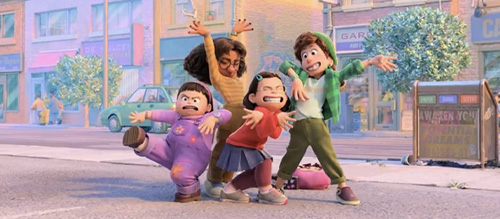Turning Red (2022) Review

Turning Red (2022)
Director: Domee Shi
Screenwriters: Domee Shi, Julia Cho, Sarah Streicher
Starring: Rosalie Chiang, Sandra Oh, Ava Morse, Hyein Park, Maitreyi Ramakrishnan, Orion Lee, Wai Ching Ho, Tristan Allerick Chen, Lori Tan Chinn, James Hong
Turning Red, the feature directorial debut of Domee Shi (Oscar-winner for the animation short Bao) is one of the most bold and visually unique films in the history of Pixar, and frustratingly like Soul and Luca before it, the film has bypassed the big screen and been sent straight to Disney+ seemingly as grist for the content mill. Seeing as the cinema is not an option for this release, we might as well curl up on the sofa and embrace this great big warm hug of a movie.
In early 2000s Toronto, 13 year-old Meilin “Mei” Lee (Rosalie Chiang) is a confident straight-A student, the apple of her parents’ (Sandra Oh and Orion Lee’s) eyes with a loyal group of dorky school friends. But it is a time of change in any teenage girl’s life, more so for Mei who starts turning into an eight foot tall red panda whenever her emotions peak.
The opening sequence of the film is Mei strutting down the street delivering a monologue to camera, showing off the many ways in which she is currently bossing life, blissfully unaware of the seismic changes on her horizon. She excels at school, her parents adore her, she has the best friends in the world, and she helps to keep her cultural heritage alive by working as a mascot at the family-owned shrine. It’s a purposefully cringeworthy scene with Mei performing like she’s delivering an over-enthusiastic school presentation on her own sense of self, but her unshakeable self-confidence is ironically in itself pretty cool.
It’s no surprise that this story comes from a team of extremely talented majority women creatives. Danielle Feinberg, the visual effects supervisor, notes she is the first woman to hold the role at Pixar in 20 years. The team’s life experiences, both good and bad, not to mention their hang ups and perceived imperfections, all went into making Mei a real and compellingly flawed person to build their story around.
Domee Shi said that “Ever since we started making this movie we’ve been breaking convention and making people laugh”. It’s certainly funny, and it’s pleasing to see how many conventions have been broken for the better here. Among other things, this is a film about the frightening sudden onset of puberty; pretty frank discussion of girls one day waking up changed and getting their period for the first time (“Did the red peony bloom?”) in family-oriented animation would be revolutionary enough on its own, but it doesn’t stop there.

Relatively few films get to show a group of girls unapologetically goofing off, getting to be themselves without putting on airs and graces (Sarah Gavron’s Rocks and Swedish film We Are The Best! are two others that spring to mind focussing on a similarly aged group of characters). Mei and her friends Miriam (Ava Morse), Abby (Hyein Park) and Priya (Maitreyi Ramakrishnan) all have their own style, in-jokes, a shared obsession with dreamy boy band 4*Town and an unbreakable bond; a bond that only strengthens when the girls band together to support Mei in her crisis, including turning the panda into a business opportunity at their school. The little naturalistic, seemingly improvised details in the vocal performances of these actors (who are actually the right age for their characters) really help to keep things grounded and sell the film’s bizarre conceit.
Mother-daughter films are still relatively rare as well, which is a shame because they’re fascinating especially when viewed via cultures with strong family values. It is Rosalie Chaing and Sandra Oh’s layered, often emotionally raw performances that really power the most important and difficult character relationship in Turning Red, that of Mei and Ming, through all of its spectacle, comic set pieces and beyond.
So why red pandas? Well Shi just really likes them. As the film’s producer Lindsey Collins suggests during a research trip to the zoo on the Disney+ making of: “They’re totally solitary, they don’t really communicate with one another, they’re kind of like teenagers”.
The biggest influence on the animation is clearly anime. The dynamic action sequences and the exaggerated way Mei and her girl gang’s eyes sparkle with joy listening to their pop star idols, and the way in which their mouths gape to express emotions too big to keep inside, wouldn’t look out of place in any long-running anime series. Everything is still just as wonderfully rich and detailed as you’d expect in a Pixar film, but the style is completely different – hyper-reality is not the aim here, expressiveness is.
The energetic animation and on-point vocal delivery are given a further boost by Ludwig Göransson’s score that somehow makes a Chinese flute mixed in with a hip-hop drum beat work as Mei’s character theme, in addition to some beautifully emotive orchestration throughout the film incorporating East Asian instruments and musical influences, much like he transmuted traditional African music for Black Panther‘s soundtrack.
The final act – describing the exact content of which would be a massive spoiler – maybe isn’t quite as perfectly conceptualised as the rest of the film, though it admittedly still has nice visual flourishes and big emotional beats in abundance.
In the same way that Inside Out and Soul probably hit a lot harder with older viewers, Turning Red will probably have the strongest connection with girls of Mei’s age or people who used to be girls of Mei’s age, but the wider appeal is universal and it is clearly such a passionate and personal work for Domee Shi. For the second movie in a row, Pixar has produced a film about the world-changing power of friendship. None of us want our parents to interfere on the day we wake up looking and feeling different, but life as teenager is a lot more bearable if you have a group of friends who will stick with you no matter what, “panda or no panda”.
21/24

